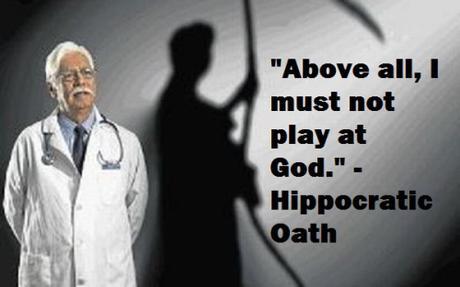After two tries, Democrats Death Eaters who dominate the California legislature finally have their way:
Euthanasia by the clinical name of “physician-assisted suicide” is now legal, signed into law by Death Eater Gov. Jerry Brown.

Steven Ertelt reports for LifeNews that on Oct. 5, 2015, California became the 4th state to legalize “assisted suicide,” following Oregon, Washington and Vermont — all “blue” states.
In his signing message, Brown said he signed the bill because he wouldn’t want to be in pain in his final days — regardless of the fact that pain relief is readily available without killing patients.
Carol Tobias of National Right to Life said this about the new law:
“The so-called ‘right-to-die’ movement promotes these laws as simply ‘another medical option’ at the end of life, but their real goal is euthanasia on demand for any reason. There are no real safeguards. It is a well-established fact that nearly every terminally ill patient who desires death is suffering from treatable depression. In Oregon, fewer than 6% of patients have been referred for psychiatric evaluation before obtaining life-ending drugs. Rather than treat clinically depressed patients, the Oregon system, and the system that would be established by the California bill, indicates that you instead help the patients kill themselves.”
Ironically, the bill was passed during a special session of the California State Legislature, which was originally called to address cost savings for the state’s MediCal program. Indeed, there are many who would see doctor-prescribed suicide as a “cost-savings” measure. Writing about the bill’s passage in The New York Times, Ian Lovett quoted Dr. Aaron Kheriaty, director of the medical ethics program at the University of California, Irvine, School of Medicine:
…[Kheriaty] said that low-income and underinsured patients would inevitably feel pressure to end their own lives in some cases, when the cost of continued treatment would be astronomical compared with the cost of a few lethal pills.
The California bill is modeled after Oregon, which, in 1994, became the first state in the nation to legalize doctor-prescribed suicide. Proponents argue that such laws are necessary to provide “compassionate aid in dying for terminally ill patients,” and point to safeguards similar to Oregon, but there are no real safeguards.
It is a well-established fact that nearly every terminally ill patient who desires death is suffering from treatable depression. In Oregon, fewer than 6% of patients have been referred for psychiatric evaluation before obtaining life-ending drugs. Rather than treat clinically depressed patients, the Oregon system, and the system that would be established by the California bill, indicates that you instead help the patients kill themselves.
The pro-life legal group Life Legal Foundation notes that the manner in which the law was passed invites a lawsuit to overturn the law. The bill, ABX2-15, was introduced during an extraordinary procedure by which the Governor can call the Legislature into session to enact legislation that cannot wait until the next regularly scheduled term. Governor Brown convened an extraordinary legislative session on June 19, 2015 to secure funding for Medi-Cal to provide for millions of new Medi-Cal beneficiaries under the Affordable Care Act.
Supporters of physician-assisted suicide, which were not successful in passing legislation during the regular session, exploited the extraordinary Medi-Cal session to advance their agenda behind closed doors. Legislation allowing doctors to prescribe lethal drugs is highly controversial and opposed by disability rights groups, hospitals, physicians’ groups, as well as by Life Legal Defense Foundation.
Life Legal Executive Director Alexandra Snyder said, “We expect our state legislators to uphold the State Constitution and not bend the law to further their own ends. Californians have a right to an open, deliberative, and transparent legislative process when it comes to law and policy changes that are literally a matter of life and death.”
While the California Constitution permits the Governor to issue proclamations to convene extraordinary legislative sessions, the Legislature is prohibited from enacting bills that are not the specific subject of the proclamation. In this case, Governor Brown’s proclamation expressly states that the purpose of the extraordinary session on Medi-Cal is to “stabilize the General Fund’s costs for Medi-Cal” and to “provide rate increases for providers of Medi-Cal and developmental disability services.” The Legislature was specifically tasked with enacting legislation to expand access to Medi-Cal services, increase oversight, and “reduce the cost of providing health care services.”
Brown himself has stated that the extraordinary session was not the proper vehicle for ABX2-15 and has recommended that the bill be taken up during the next session.
Alex Schadenberg of the Euthanasia Prevention Coalition tells LifeNews.com that people need to know of the dangers associated with assisted suicide:
“Does legalizing assisted suicide show care and concern to someone who is living with psychological pain? Recently, Dr Will Johnston wrote about a young adult patient who became suicidal after watching a video about Brittany Maynard, the California woman who moved to Oregon to die by assisted suicide. He said, “A primary risk associated with depression is suicidal ideation. The data indicates that legalizing assisted suicide does not reduce suicide, rather it appears to have a suicide contagion effect.”
Other experts on assisted suicide and euthanasia say lawmakers are ignoring problems in other states that have passed it. Margaret Dore, president of Choice is an Illusion, said this about ABX2-15:
“The bill is sold as giving people choice and control at the end of life. Yet the bill’s language is stacked against the patient and applies to people with years, even decades, to live.The bill applies to people with a ‘terminal disease,’ which is defined as having less than six months to live. Most people thinks this means ‘dying.’ However, in Oregon, which uses a nearly-identical definition of terminal disease, an 18-year-old with insulin-dependent diabetes is ‘eligible’ for assisted suicide. Doctors are often wrong at predicting life expectancy. Sadly, this bill encourages people with years, even decades, to live to throw away their lives.”
In my law practice, I started out working in guardianships, wills and probate, and saw abuse of all kinds, especially where there was money involved (where there’s a will, there are heirs). The California bill sets up the perfect crime: your heir can actively participate in signing you up for the lethal dose and once the lethal dose is in the home, there’s no oversight –not even a witness is required. If you resisted or struggled, who would know?”

The Netherlands and Belgium show how physician-assisted suicide can be and is being abused, resulting in doctors killing people who are not terminally-ill, including the elderly, the young, the mentally ill, and babies. See:
- Up to 650 babies euthanized every year in Holland
- 1/3 of Dutch physicians are willing to kill the mentally ill
- Belgium’s culture of death: Woman, 24, granted right to die by euthanasia over suicidal thoughts: ‘Life, that’s not for me’
See also “Why you should be concerned that the largest U.S. nursing association endorses socialist Bernie Sanders for President” (Hint: Sanders is pro-euthanasia.)
H/t FOTM’s MomOfIV
~Éowyn

